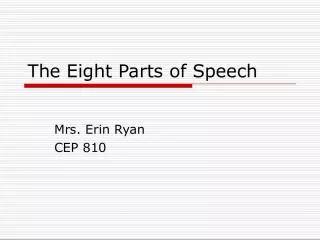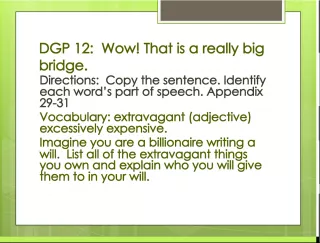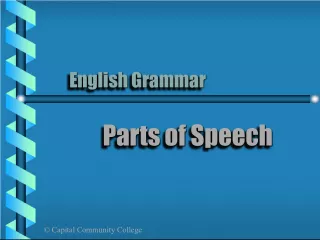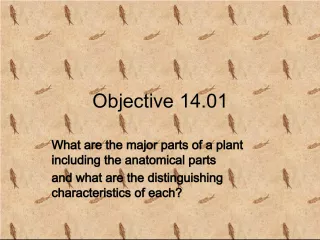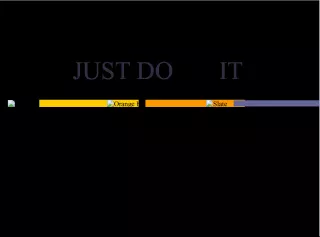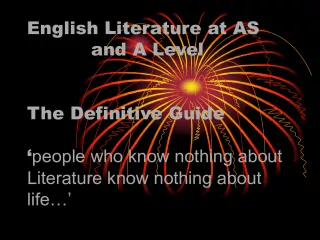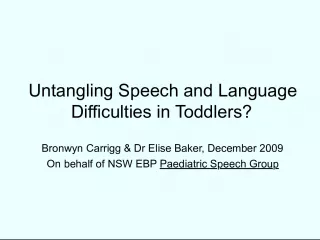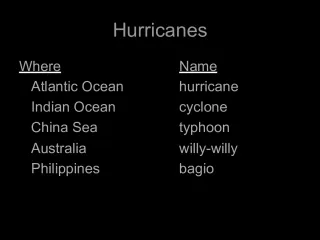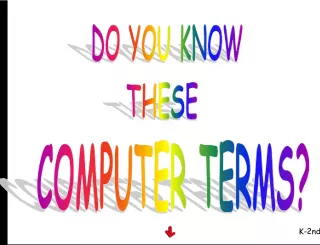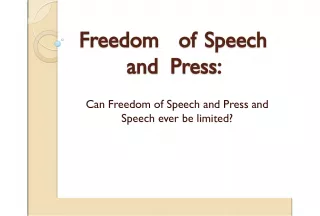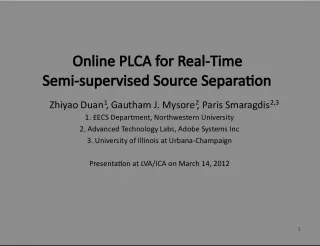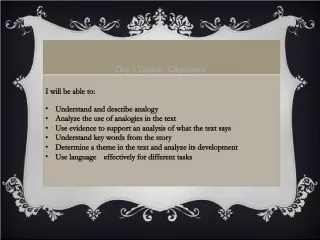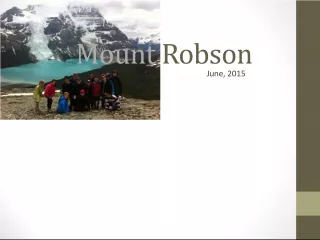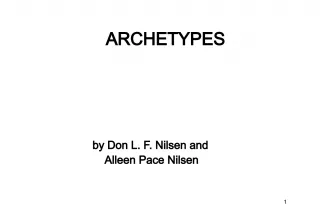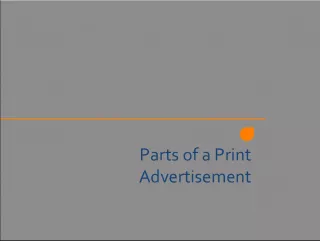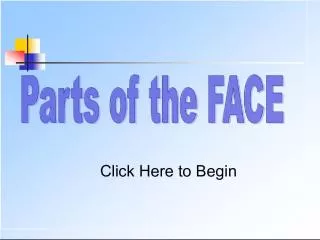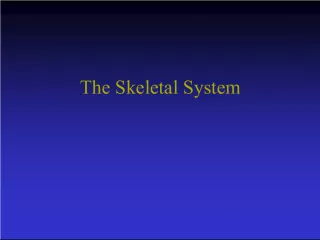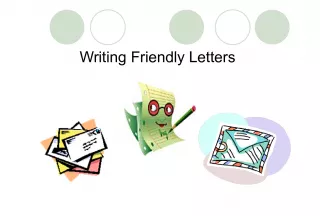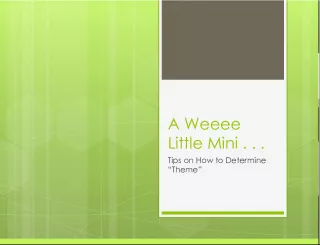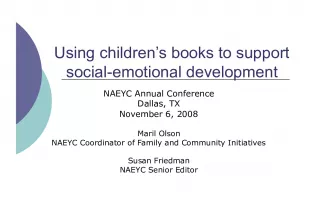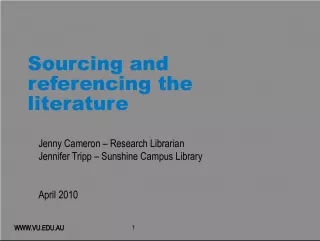The Eight Parts of Speech - Sixth Grade Literature
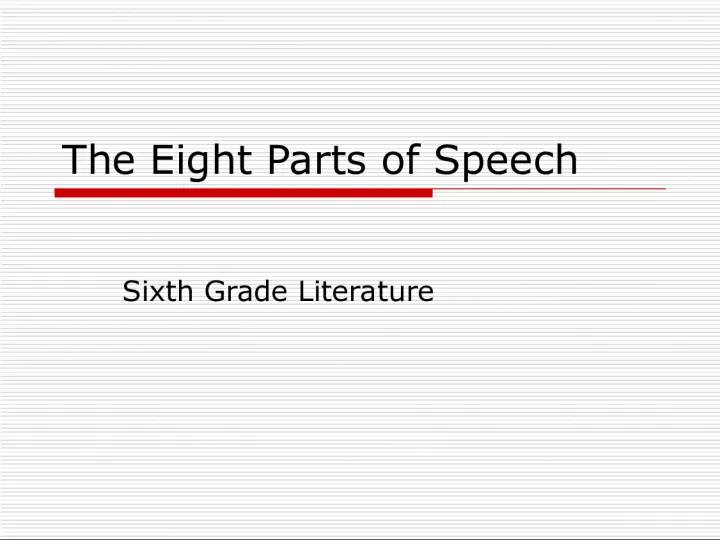

This PowerPoint presentation covers the eight parts of speech, which are nouns, pronouns, adjectives, verbs, adverbs, conjunctions, prepositions, and interjections. Each
- Uploaded on | 5 Views
-
 nieves
nieves
About The Eight Parts of Speech - Sixth Grade Literature
PowerPoint presentation about 'The Eight Parts of Speech - Sixth Grade Literature'. This presentation describes the topic on This PowerPoint presentation covers the eight parts of speech, which are nouns, pronouns, adjectives, verbs, adverbs, conjunctions, prepositions, and interjections. Each. The key topics included in this slideshow are . Download this presentation absolutely free.
Presentation Transcript
Slide1The Eight Parts of SpeechSixth Grade Literature
Slide21.Noun 2. Pronoun 3. Adjective 4. Verb 5. Adverb 6. Conjunction 7. Preposition 8. Interjection You can click on each part of speech for a definition and example. However, this is not required as you will come to each page as you progress through the PowerPoint.
Slide3A noun is a person, place, thing, or idea. Nouns are the subject of a sentence. Kylie is a pro-golfer. The bakery has fresh baked goods. The dog was lonely for me. Love is a beautiful thing. Go back to Eight Parts of Speech Move on Grammar Rock Nouns
Slide4In the following sentence, which wordsare nouns? Caleb loves to play Nintendo DS . a. loves b. play c. Caleb and Nintendo DS
Slide5No, that is not correct. Remember anoun is a person, place, thing, or idea. Please try again! Go back to Slide 5
Slide6Great job! Caleb and Nintendo are thenouns in this sentence. Caleb is a person and Nintendo DS is a thing. Move on
Slide7Common Noun- A noun that does not name a specific person, place or thing. Proper Noun- A noun that names a specific person, place or thing. Move on New York City dog
Slide8The cow jumped over the moon . We celebrated my birthday with a great, big, chocolate cake . I ran the 5k race in town last week . The cherries were very tasty. I played basketball in gym class today. Move on
Slide9In the following sentence, what is the common noun? Shaun cut the grass. a. Shaun b. cut c. grass
Slide10No, Shaun is a proper noun becauseit names a specific person. The word cut is verb because it tells what Shaun is doing. Try again- What is the common noun? Go back to slide 10
Slide11Yes! You are really getting the hangof this. Grass is the common noun in this sentence because it is a thing but is not specific. Move on
Slide12West Middle School is a great place to learn! Caleb and Kylie are the best kids in the world. I went to Horizon Cinemas to watch the movie Speed Racer . Read 180 has many good books to choose from. Shopping at the Grand Traverse Mall can be hectic during the holidays. Move on
Slide13Now let’s try proper nouns. Remember they name a specific person, place, or thing. What is the proper noun in this sentence? He walked across the Mackinaw Bridge. a. he b. Mackinaw Bridge c. walked
Slide14Oops! He is not the proper nounbecause “he” can be referring to anyone, not someone specific. Walked is the verb of the sentence. It tells what he is doing. Go back and try finding the proper noun. Look at the other examples if needed. Go back to slide 14
Slide15Excellent! Mackinaw Bridge is theproper noun! It names a specific place. Move on
Slide16A pronoun is a word that takes the place of a noun. Examples: I, me, my, you, your, he, she, it , us, we, they, them, his, her, their, mine, our, myself, himself, herself, itself, yourself, themselves, ourselves, who, whose, whom, anybody, anyone, everybody, nobody, someone, somebody. Move on Go back to Eight Parts of Speech Grammar Rock Pronouns
Slide17A pronoun is word that takes the place of a noun. Instead of saying “Erin likes to eat”, you could say, “She likes to eat.” What is the pronoun in the following sentence? I sing loudly in the shower. a. sing b. loudly c. I d. shower
Slide18Good try but, sing cannot be the pronoun because it is the action. Loudly describes how I was singing. Shower is noun, a thing. See if you can find the pronoun. Go back and try again. Go back to slide 18
Slide19Awesome! I is the pronoun because it takes the place of a noun. I replaces someone more specific like girl, boy, Bob, or Mrs. Ryan. Move on
Slide20An adjective is a word that describes a noun or pronoun. It tells what kind, how many, or which one. Move on green shirt sour limes Go back to Eight Parts of Speech Grammar Rock Adjectives
Slide21Adjective- An adjective is a word that describes a noun or pronoun. It tells what kind, how many, or which one. Here is an example: Erin has blonde hair . Which word describes in this sentence. What is the adjective? a. blonde b. Erin c. hair
Slide22No the answer is not Erin because that is the noun or subject of the sentence. Hair is also a noun. It does not describe anything. Good try- you can do this! Go back to slide 22
Slide23You are so smart! A. is the correct answer because blonde describe Erin’s hair! Great work. Move on
Slide24A verb is the action of the sentence. It shows what someone or something is doing. Move on run paint read Go back to Eight Parts of Speech Grammar Rock Verbs
Slide25Verb- A verb is the action of the sentences What is the subject doing? In the example below, find the verb. Erin is running the 5K. What is Erin doing? a. Is b. 5K c. running
Slide26Oops! Your answer is not correct. “Is” is a helping verb. 5K is a type of race which means it is a noun. Go back to slide 26
Slide27Yes! C. is the correct answer. Running is the verb. It tells what Erin is doing in the sentence. Move on
Slide28An adverb describes how the action is performed. They tell how much, how often, when and where something is done. Move on The fished jumped quickly from the water. The man sat alone . Go back to Eight Parts of Speech Grammar Rock Adverbs
Slide29Adverb- An adverb describes how the action is performed. They tell how much, how often, when and where something is done. Erin ran the 5K quickly . How did she run the 5K? a. Erin b. ran c. quickly
Slide30Good try- Adverbs are challenging! Erin is the noun, the subject of the sentence. Ran is the verb. It tells what Erin is doing. What describes how Erin ran? Go back to slide 30
Slide31Fantastic! I am impressed! The adverb in the sentence is quickly. It tells how Erin ran the 5K race. Move on
Slide32A conjunction is a word that joins words or word groups together. Some examples conjunctions are: and, but, or, nor, although, yet, so, either, and also. Move on We ate pizza and drank pop for dinner. Go back to Eight Parts of Speech Grammar Rock Conjunction
Slide33Conjunction- A conjunction is a word that joins words or word groups together. Some examples conjunctions are: and, but, or, nor, although, yet, so, either, and also. Check out this example: Erin loves to swim and play at the beach. What is the conjunction in this sentence? a. beach b. swim, play c. at d. and
Slide34Sorry! Beach is a thing, a noun. Swim and play are verbs. They tell what Erin is doing. At is a preposition because it shows the position. Please go back and look for word that connects two ideas. Go back to slide 34
Slide35Great! And is the conjunction in this sentence because it connects two word groups- Erin loves to swim AND play at the beach. Move on
Slide36A preposition is a word that shows position or, direction. Some examples are in, out, under, over, after, out, into, up, down, for, and between. Move on She worked at her desk. The sun was in the sky. Go back to Eight Parts of Speech Grammar Rock Prepositions
Slide37Preposition- A preposition is a word that shows position or, direction. Some examples are in, out, under, over, after, out, into, up, down, for, and between. Try this. I ran towards the school bus. Ask yourself first, “What did I do?” I ran. Now ask, “Where- in which direction did I run?” What is the preposition in this sentence? a. towards b. ran c. school bus
Slide38Did you ask yourself those questions? It is okay. Ran is the verb in the sentence (what I am doing) and school bus is a noun (a thing). Which direction did I run? Go back to slide 38
Slide39You are correct! Towards is the conjunction of this sentence because it tells the direction that I ran. Awesome work! Move on
Slide40Interjection- An interjection is a word that shows strong emotion. Such examples are Wow!, Ouch!, Hurray!, and Oh no! Interjections can really liven up a sentence. They help to add voice to your writing. Move on Go back to Eight Parts of Speech Grammar Rock Interjection
Slide41Interjection- An interjection is a word that shows strong emotion. Such examples are Wow!, Ouch!, Hurray!, and Oh no! Interjections can really liven up a sentence. They help to add voice to your writing. Check this out. Whew! I am so glad to have passed my exam. The word “Whew!” shows that I am relieved about passing my exam. Now you try it. Wow! You did a fabulous job. What is the interjection in this sentence? a. job b. fabulous c. Wow!
Slide42Oops! The word job is a noun (a thing). It really does not show emotion. Fabulous is great word but in this sentence it is used as an adjective. It describes the job you did. Go back and try again. Go back to slide 42
Slide43Superb! (That is an interjection) The correct answer is c. The word Wow! shows excitement and emotion. Move on
Slide44Great job everyone! The parts of speech are very difficult. Let’s do a review to be sure you know what each part of speech is. Move on
Slide45I am a person, place, thing or idea. What am I? a. adjective b. verb c. preposition d. noun
Slide46Good try! Remember an adjective describes a verb. A verb shows action and a preposition shows position or direction. Go back and try again. Go back to slide 45
Slide47Excellent! A NOUN is a person, place, thing or idea! Move on
Slide48I am a word that shows action. What am I? a. verb b. noun c. pronoun d. interjection
Slide49Oops, a noun is a person, place, thing, or idea. A pronoun takes the place of a noun. A preposition shows position or direction. Please give this another try! Go back to slide 48
Slide50Excellent. A VERB shows action! Move on
Slide51I connect words or groups of words to make a complete sentence. a. adjective b. verb c. adverb d. conjunction
Slide52Try again! An adjective describes a noun. A verb tells the action and an adverb describe how the action is done. You can do this! Go back to slide 51
Slide53Awesome! You have really got this. A CONJUNCTION connects words and word phrases to make complete sentences. Move on
Slide54I show emotion in a sentence. What am I? a. adjective b. interjection c. verb d. noun
Slide55Sorry. An adjective describes a noun. A verb shows action and a noun is a person, place, thing, or idea. Go back and find what part of speech shows strong emotion. Go back to slide 54
Slide56Yes!!! An INTERJECTION shows strong emotion in a sentence. You are correct! Move on
Slide57I describe a noun. I tell what kind, how many, or which one. What am I? a. adjective b. pronoun c. conjunction d. adverb
Slide58No. You must try again. A pronoun takes the place of a noun. A conjunction connects words and phrases. An adverb tells how an action is done. Please go back. Go back to slide 57
Slide59You rock! An ADJECTIVE describes a noun and tells how many, which one, and what kind. Great Work! Move on
Slide60I describe a verb. I tell how something is done. a. adjective b. verb c. adverb d. preposition
Slide61Good try. Remember an adjective is a word that describes a noun. A verb is the action. A preposition shows position or direction. Look for the word that describes the action. Go back to slide 60
Slide62Wonderful. An ADVERB describes a verb. It tells how the action is done! Move on
Slide63I take the place of noun. What am I? a. preposition b. verb c. interjection d. pronoun
Slide64Okay. Remember a preposition shows direction or position. A verb is the action. An interjection is a word that shows strong emotion. Go back and try this one again. Go back to slide 63
Slide65Very good job! A PRONOUN takes the place of noun. Move on
Slide66I show position or direction. What am I? a. adjective b. noun c. preposition d. pronoun
Slide67No. An adjective describes a noun and a noun is a person, place, thing, or idea. A pronoun takes the place of a noun. Look for the part of speech that shows position or direction. Go back to slide 66
Slide68Bravo! A PREPOSITION shows position or direction in a sentence. Move on to your last task!
